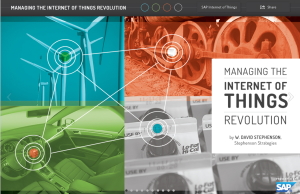I’ve been writing about what I call the Internet of Things’ “Essential Truths” for three years now, and decided the time was long overview to codify them and present them in a single post to make them easy to refer to.
As I’ve said, the IoT really will bring about a total paradigm shift, because, for the the first time, it will be possible for everyone who needs it to share real-time information instantly. That really does change everything, obliterating the “Collective Blindness” that has hampered both daily operations and long-term strategy in the past. As a result, we must rethink a wide range of management shibboleths (OK, OK, that was gratuitous, but I’ve always wanted to use the word, and it seemed relevant here, LOL):
- First, we must share data. Tesla leads the way with its patent sharing. In the past, proprietary knowledge led to wealth: your win was my loss. Now, we must automatically ask “who else can use this information?” and, even in the case of competitors, “can we mutually profit from sharing this information?” Closed systems and proprietary standards are the biggest obstacle to the IoT.
- Second, we must use the Internet of Things to empower workers. With the IoT, it is technically possible for everyone who could do their job better because of access to real-time information to share it instantly, so management must begin with a new premise: information should be shared with the entire workforce. Limiting access must be justified.
- Third, we must close the loop. We must redesign our data management processes to capitalize on new information, creating continuous feedback loops.
- Fourth, we must rethink products’ roles. Rolls-Royce jet engines feed back a constant stream of real-time data on their operations. Real-time field data lets companies have a sustained dialogue with products and their customers, increasingly allowing them to market products as services, with benefits including new revenue streams.
- Fifth, we must develop new skills to listen to products and understand their signals. IBM scientists and medical experts jointly analyzed data from sick preemies’ bassinettes & realized they could diagnose infections a day before there was any visible sign. It’s not enough to have vast data streams: we need to understand them.
- Sixth, we must democratize innovation. The wildly-popular IFTTT web site allows anyone to create new “recipes” to exploit unforeseen aspects of IoT products – and doesn’t require any tech skills to use. By sharing IoT data, we empower everyone who has access to develop new ways to capitalize on that data, speading the IoT’s development.
- Seventh, and perhaps most important, we must take privacy and security seriously. What responsible parent would put an IoT baby monitor in their baby’s room after the highly-publicized incident when a hacker exploited the manufacturer’s disregard for privacy and spewed a string of obscenities at the baby? Unless everyone in the field takes privacy and security seriously, the public may lose faith in the IoT.
There you have ’em: my best analysis of how the Internet of Things will require a revolution not just in technology, but also management strategy and practices. What do you think?





